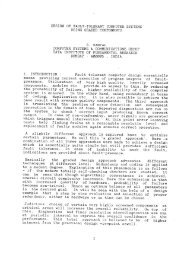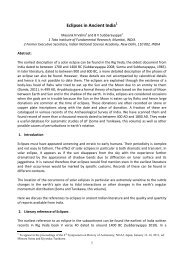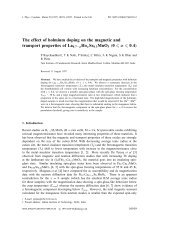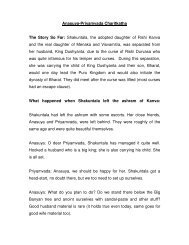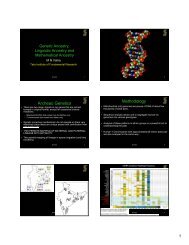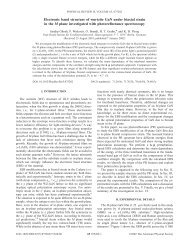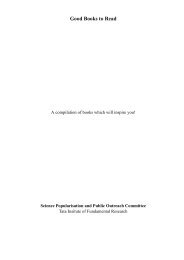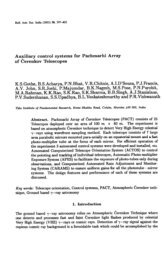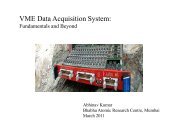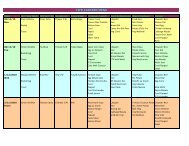GRAVITATION - Indian tradition
GRAVITATION - Indian tradition
GRAVITATION - Indian tradition
Create successful ePaper yourself
Turn your PDF publications into a flip-book with our unique Google optimized e-Paper software.
<strong>GRAVITATION</strong> -<br />
<strong>Indian</strong> <strong>tradition</strong><br />
V C Kuriakose<br />
CUSAT, Kochi
►Gravity Gravity is one of those things we take<br />
completely for granted.<br />
► it is always there,<br />
► it never changes
►Chronology Chronology of developments of<br />
physics and astronomy<br />
►Greek Greek’s s thoughts (Aristotle)<br />
►Nicholas Nicholas Copernicus((AD<br />
Copernicus( (AD 1473 – 1543,<br />
Poland) Poland<br />
►John John Kepler<br />
(AD 1571- 1571 1630,Germany)<br />
►Galileo Galileo (AD1564-1642, (AD1564 1642, Italy)<br />
►Isaac Isaac Newton (1642-1727, (1642 1727, UK)
►Kanada Kanada (Kanad)<br />
►<br />
Kanad) - around BC 600<br />
- Father of atomic theory:<br />
- In his text, the Vaisheshik Darshana, Darshana he describes an<br />
atomic theory<br />
more than a century before Democritus<br />
- All objects were composed of nine elements:<br />
earth water light wind<br />
ether time space mind soul.<br />
- Gurutva (gravitation<br />
( gravitation) ) was responsible for the falling<br />
of objects on the Earth.
Aryabhatta born in (AD 476 –<br />
►<br />
550) .
Statue of<br />
Aryabhata<br />
on the grounds<br />
of<br />
IUCAA, Pune.
► Aryabhata<br />
is the father of the Hindu-Arabic<br />
Hindu Arabic or<br />
the Decimal number system<br />
- the Earth to spin on its axis, the planets move with<br />
respect to the Sun.<br />
- the Earth's circumference and diameter,<br />
- explained the lunar eclipse and solar eclipse<br />
- measured radius of the planetary orbits in terms of<br />
the radius of the Earth/Sun orbit<br />
- their periods of rotation around the Sun.<br />
- orbits of the planets around the Sun are ellipses.<br />
Aryabhatta's master piece, the Aryabhattiya,<br />
Aryabhattiya,<br />
was translated into Latin in the 13th century
►Varahamihira (AD AD 505 –<br />
587) 587<br />
Existence of force which might be keeping<br />
bodies stuck to the Earth, and also keeping<br />
heavenly bodies in their determined places. places.<br />
The school of mathematics at Ujjain<br />
►sin sin xx = cos(π/2 cos( /2 - xx), ),<br />
►Sin^2( Sin^2(x) x) + cos^2( cos^2(xx )= 1, and<br />
►(1 (1 -<br />
cos<br />
2xx)/2 )/2 = sin^2( sin^2(x) x). .
►Brahmagupta<br />
Brahmagupta, (7th century)<br />
He was the head of the astronomical observatory at<br />
Ujjain<br />
"Bodies fall towards the Earth as it is in the<br />
nature of the Earth to attract bodies, just as it is<br />
in the nature of water to flow".<br />
Gurutvakarshan : amalgam of Guru-tva Guru tvaakarshan<br />
- Gurutvakarshan<br />
-<br />
law of gravitations, sine tables and the<br />
concept of trigonometry
►describes describes Zero as one of the numerals<br />
which stood for meaning nothing.<br />
► elaborates as to how integers positive<br />
and negative consequence when played<br />
with zero.
►Bh Bhāskara skara<br />
I<br />
(AD600 -<br />
680 )<br />
►first first to write numbers in the Hindu-Arabic<br />
Hindu Arabic<br />
decimal system<br />
with a circle for the zero, zero,<br />
and who gave a unique and remarkable<br />
rational approximation<br />
of the sine<br />
function<br />
in his commentary on Aryabhata's<br />
Aryabhata's<br />
work<br />
►born born in Kerala<br />
as a Nambudiri<br />
Brahmin<br />
►He He and Brahmagupta<br />
are the most<br />
renowed<br />
<strong>Indian</strong> mathematicians who<br />
made considerable contributions to the<br />
study of fractions
►BHASKARA BHASKARA II (Bhaskaracharya<br />
( Bhaskaracharya)<br />
►Born: Born: 1114 in Vijayapura, Vijayapura,<br />
India<br />
Died: 1185 in Ujjain, Ujjain,<br />
India<br />
►Bhaskaracharya<br />
Bhaskaracharya became head of the<br />
astronomical observatory at Ujjain<br />
►built built up a strong school of mathematical<br />
astronomy.
►he he knew that x^2 x^2<br />
= 9 had two solutions.<br />
He also gave the formula
Kerala<br />
school of astronomy<br />
and mathematics :<br />
►Madhava Madhava of Sangamagrama<br />
►Parameshvara<br />
Parameshvara, ,<br />
►Neelakanta Neelakanta Somayaji, Somayaji,<br />
►Jyeshtadeva<br />
Jyeshtadeva, ,<br />
►Achyuta Achyuta<br />
►Melpathur Melpathur<br />
►Achyuta Achyuta<br />
Pisharati, Pisharati,<br />
Narayana<br />
Panikkar. Panikkar.<br />
Bhattathiri<br />
and
►The The school flourished between the 14th<br />
and 16th centuries and the original<br />
discoveries of the school seems to have<br />
ended with Narayana<br />
Bhattathiri<br />
(1559- (1559<br />
1632)<br />
►Their Their most important results—series<br />
results series<br />
expansion for trigonometric functions— functions<br />
were described in Sanskrit<br />
verse in a book<br />
by Neelakanta<br />
called Tantrasangraha, Tantrasangraha,<br />
and<br />
again in a commentary on this work,<br />
called Tantrasangraha--vakhya<br />
Tantrasangraha vakhya, , of<br />
unknown authorship
►The The theorems were stated without proof,<br />
but proofs for the series for sine, cosine,<br />
and inverse tangent were provided a<br />
century later in the work Yuktibhasa Yuktibhasa<br />
(c.1500-c.1610), (c.1500 c.1610), written in Malayalam, Malayalam,<br />
by<br />
Jyesthadeva, Jyesthadeva,<br />
and also in a commentary on<br />
Tantrasangraha.<br />
Tantrasangraha.
►Their Their work, completed two centuries<br />
before the invention of calculus<br />
in Europe,<br />
provided what is now considered the first<br />
example of a power series<br />
(apart from<br />
geometric series). However, they did not<br />
formulate a systematic theory of<br />
differentiation<br />
and integration, integration,<br />
nor is there<br />
any direct evidence of their results being<br />
transmitted outside Kerala
►Madhava Madhava of Sangamagrama<br />
(c. 1340- 1340<br />
1425) lived at Irinjalakuda:<br />
Irinjalakuda:<br />
►Madhava Madhava’s discoveries include<br />
Nilkantha<br />
attributes the series for sine sine to<br />
Madhava. Madhava.<br />
►the the Taylor series for the sine, cosine,<br />
tangent and arctangent functions;<br />
►the the second-order second order Taylor series<br />
approximations of the sine and cosine<br />
functions and the third-order third order Taylor series<br />
approximation of the sine function;
► the power series of π, , usually attributed to<br />
Leibniz<br />
but now known as the Madhava-Leibniz<br />
Madhava Leibniz<br />
series; series<br />
► the solution of transcendental equations<br />
by<br />
iteration; iteration<br />
► the approximation of transcendental numbers<br />
by<br />
continued fractions. fractions<br />
► Madhava<br />
correctly computed the value of π to 9<br />
decimal places and 13 decimal places,<br />
► produced sine and cosine tables to 9 decimal<br />
places of accuracy<br />
► extended some results found in earlier works,<br />
including those of Bhaskara. Bhaskara.
►Jyesthadeva<br />
Jyesthadeva<br />
(c. 1500-1600)<br />
1500 1600)<br />
►Yuktibhasa Yuktibhasa (in Malayalam)<br />
Malayalam)<br />
- the world's<br />
first Calculus<br />
text<br />
►contains contains proofs of theorems, derivations<br />
of rules and series, a derivation and proof<br />
of the Madhava-Gregory Madhava Gregory series of the<br />
arctangent function, proofs of most<br />
mathematical theorems and infinite series<br />
earlier discovered by Madhava<br />
and other<br />
mathematicians of the Kerala
NP-2005-8-711-GSFC<br />
NASA: Explore. Discover. Understand.<br />
http://www.nasa.gov/



